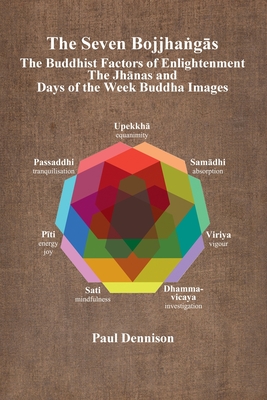The Bojjhaṅgās: The Buddhist Factors of Enlightenment, the Jhānas and Days of the Week Buddha Images

The Bojjhaṅgās: The Buddhist Factors of Enlightenment, the Jhānas and Days of the Week Buddha Images
This monograph bridges ancient understandings of Buddhist meditation and the Bojjhaṅgas, the "Factors of Enlightenment", with cutting-edge modern neuroscience. It also describes the age-old practice of associating different Buddha images with the day of the week on which a person is born. This practice may be familiar to readers who have visited a Buddhist temple and seen sets of seven images in front of which individuals, children and adults alike, make offerings, puja, to the image corresponding to their day of birth. The cultural understandings of this practice are described, together with the deeply symbolic meanings behind the postures and mudras of the images, and how each image is related to one of the Bojjhaṅgas. Each of the images are beautifully illustrated. The Bojjaṅgās are very ancient, direct teachings of the Buddha over 2500 years ago, recorded in Suttas composed during the approximately 200 years after his death up to the reign of the Indian Emperor Asoka. They are deeply embedded in Buddhist popular culture, chanted not only for recollection of the Path to Enlightenment, but also for healing, either for oneself or others. They are also closely related to the jhānas, esoteric Buddhist meditation practices that allow meditators to temporarily disengage from their everyday sensory consciousness into a new form of consciousness, jhāna consciousness, which facilitates insight and direct understanding. The author, Paul Dennison originally trained as a research physicist and radio-astronomer in Cambridge, UK, but is more recently known as a psychotherapist and Jungian analyst based in London. He is a founder trustee of the Samatha Trust, and has practiced and taught Buddhist meditation for more than 50 years. From 2012 he developed the first detailed neuroscience study of the ancient tradition of jhāna meditation, the remarkable results published in 2019 in the leading academic journal Frontiers in Human Neuroscience.
PRP: 142.29 Lei
Acesta este Prețul Recomandat de Producător. Prețul de vânzare al produsului este afișat mai jos.
128.06Lei
128.06Lei
142.29 LeiIndisponibil
Descrierea produsului
This monograph bridges ancient understandings of Buddhist meditation and the Bojjhaṅgas, the "Factors of Enlightenment", with cutting-edge modern neuroscience. It also describes the age-old practice of associating different Buddha images with the day of the week on which a person is born. This practice may be familiar to readers who have visited a Buddhist temple and seen sets of seven images in front of which individuals, children and adults alike, make offerings, puja, to the image corresponding to their day of birth. The cultural understandings of this practice are described, together with the deeply symbolic meanings behind the postures and mudras of the images, and how each image is related to one of the Bojjhaṅgas. Each of the images are beautifully illustrated. The Bojjaṅgās are very ancient, direct teachings of the Buddha over 2500 years ago, recorded in Suttas composed during the approximately 200 years after his death up to the reign of the Indian Emperor Asoka. They are deeply embedded in Buddhist popular culture, chanted not only for recollection of the Path to Enlightenment, but also for healing, either for oneself or others. They are also closely related to the jhānas, esoteric Buddhist meditation practices that allow meditators to temporarily disengage from their everyday sensory consciousness into a new form of consciousness, jhāna consciousness, which facilitates insight and direct understanding. The author, Paul Dennison originally trained as a research physicist and radio-astronomer in Cambridge, UK, but is more recently known as a psychotherapist and Jungian analyst based in London. He is a founder trustee of the Samatha Trust, and has practiced and taught Buddhist meditation for more than 50 years. From 2012 he developed the first detailed neuroscience study of the ancient tradition of jhāna meditation, the remarkable results published in 2019 in the leading academic journal Frontiers in Human Neuroscience.
Detaliile produsului









